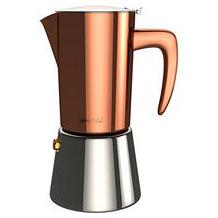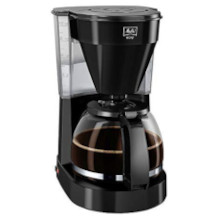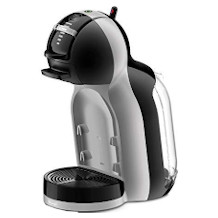French press purchasing advice: how to choose the right product
- What you need to know
- A French press is a cost-effective alternative to traditional coffee makers.
- Beside a French press, you need nothing more than coarsely ground coffee and hot water.
- Coffee from a French press is characterized by its particularly intense aroma.
- They are particularly fancied as designer objects.
Stylish coffee making
For many people, coffee is simply part of the morning routine. There are countless ways to prepare it. Every coffee drinker has their own ritual. A very inexpensive option compared to a coffee maker is the French press. The coffee is made within minutes and can be served directly from the stylish pot.
A French press — also called a cafetière, coffee press, or coffee plunger — is extremely easy to use. First, ground coffee is placed in the cylindrical beaker and infused with hot water. Then the plunger with the metal mesh is used after the coffee has been allowed to steep for a few minutes. The mesh separates the powder from the coffee.
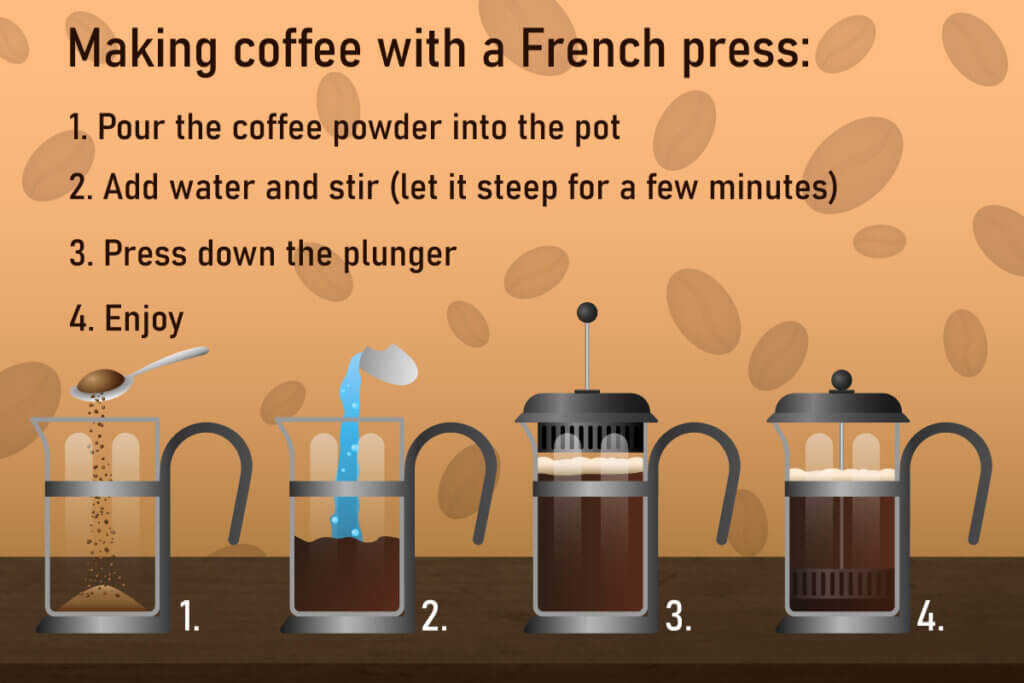
The French press originated in France, where it was invented around 1850. However, it did not become popular until much later. The first one that resembled today’s designs, was patented by the Italian Attilio Calimani in 1929. The French press gained popularity from 1974, when the Danish company Bodum launched the first model in the form we know today.
Whom is a French press for?
A French press is ideal for anyone who likes to drink coffee. The ease of use and easy cleaning make it one of the most popular coffee makers. If you don’t want to use a machine, you can also use the French press to quickly make great-tasting coffee. Depending on the size of the model, it can be used to serve an entire breakfast party.
Coffee connoisseurs in particular swear by the French press. They praise the easy preparation and the intense aroma. The special taste comes from the fact that the metal mesh, unlike a conventional filter, doesn’t filter out the oils and fats of the coffee powder. Those who prefer mild coffee should take note of this.
The French press is a perfect coffee maker for purists who prefer to drink black coffee and attach importance to brewing their own beverage. The making, unlike a vending machine, offers full control over the taste result. Pragmatists may feel rather disturbed by this very brewing process. Lovers of latte and cappuccino will also not get their money’s worth with a French press. Those who want a wider range of coffee variations are better served with a fully automatic machine. Another advantage of the French press is that there is no need to buy pods or capsules.
Not all coffee is the same
With a French press, you get filter coffee. In contrast, a fully automatic coffee maker uses a different brewing process: the machines run hot water through a compressed coffee puck for a long time. So, the coffee from a French press and that from a fully automatic coffee maker are not directly comparable.
Pros and cons of a French press
You don’t need to buy a fancy machine to enjoy a great coffee at home. The French press is a space-saving, cost-efficient, and environmentally-friendly alternative to conventional coffee makers. It is, however, not the best choice for every kind of coffee lover.
Advantages
- Comparatively low price
- No energy consumption
- Easy use and cleaning
- Everywhere ready to use
- Makes coffee for several people
- Powerful aroma
Disadvantages
- Fine residues of the powder end up in the coffee
- Fragile glass beaker
- No automated brewing
What beverages can a French press make?
A French press can make beverages other than coffee. It can filter tea in the same way. You can even froth milk with the pot by quickly moving the plunger up and down. Cold brew is another trendy drink that can be made with a French press.
How to make a cold brew coffee
The coarsely ground coffee powder is poured into the pot with cold water and stirred once. Then the lid is placed on the pot without pressing the plunger or stirring the mixture. The drink then waits in the refrigerator for 8 to 24 hours, depending on preference. After that, the plunger can be pressed down, and the cold brew coffee can be poured into another receptacle or enjoyed directly.
How much is a French press?
A high-quality, well-working French press can be obtained for as little as $10 to $60. Single-glazed models with poor insulation properties can be found for even less. The better these properties, the higher the price, although this can be hard to measure. On the one hand, the coffee shouldn’t cool too quickly, on the other hand, it shouldn’t stay in the beaker for too long, as the coffee grounds keeps releasing aromas. To avoid this, more cost-intensive models come with two meshes or silicon rings. If you don’t like to spend extra money on it, pour your coffee in a mug thermos jug after it is done.
One aspect of a French press’s price that has nothing to do with the coffee’s taste is the design. For many, drinking coffee is also an aesthetic experience. Special designs can, however, get very expensive.
Frequently asked questions
To ensure that your first try with the French press is successful, it is advisable to clarify a few questions beforehand.
What type of coffee do I need?
Since there are no special roasts for the French press, the choice of bean and roast is entirely up to you. So, you can choose freely according to your taste.
How must the coffee be ground?
Unlike classic filter coffee, the coffee should not be ground too finely for the French press. Otherwise, the result will be bitter. On the other hand, if the powder is too coarse, the coffee can become sour. A medium grind provides the best result. You can experiment a bit until you find your personal taste.
How long does the coffee have to steep?
This depends on how strong it should be. The rule of thumb is to let the coffee steep for about four minutes with water at 203 °F (95 °C) before pressing down the plunger. It is sufficient to stir the mixture once at the beginning. Further stirring during the brewing process can cause aroma to be lost.
How much coffee do I need?
2.1 ounces (60g) of coffee, or about six heaping tablespoons, is enough for one liter of water. Whether more or less powder is used depends on personal preference.
What types are available?
A French press consists of two components. First, there is the beaker, which is usually made of glass. Ceramic and stainless steel are also common materials. Many glass models have frames made of plastic. The other component is the lid, through which a plunger passes. At the end of the rod sits the metal mesh. Cheaper models often have a mesh made of plastic. However, such meshes wear out quickly. The mesh separates the coffee grounds from the water and the coffee can be poured directly into a cup. No matter what material a French press is made of, the process doesn’t change.
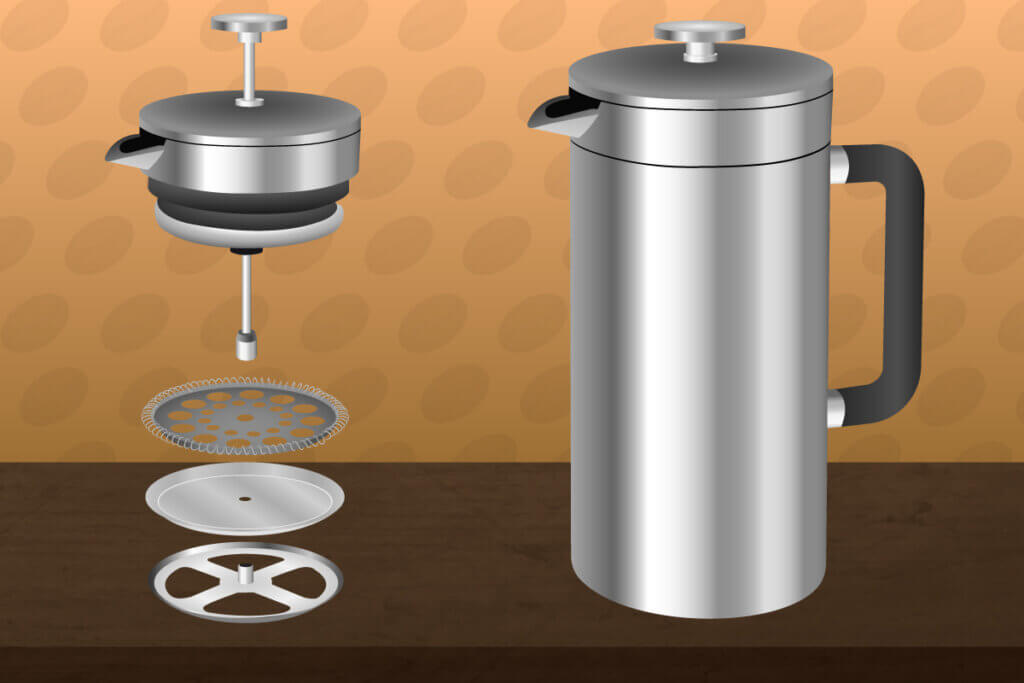
Glass
A glass beaker with a metal frame is the most common. It embodies the typical French press character. Such a model is characterized by light weight and easy cleaning. However, the beaker heats up quite a bit when hot water is poured into it. So, a little caution is required here. In addition, many models from the low-price segment contain plastic parts. If you want a plastic-free product, choose a French press with a metal frame. A glass French press is well suited for starting out in this type of coffee making. It is inexpensive and beginners can watch what happens to the coffee. The cylindrical pot is the heart of any French Press. Well-known manufacturers such as Bodum, Emsa, or Alessi rely on the particularly resistant borosilicate glass. This material is stable, doesn’t heat up much and is dishwasher safe.
Advantages
- Light weight
- Inexpensive
- Easy cleaning
Disadvantages
- Not break-proof
- Beaker heats up a lot
Ceramic
French presses made of ceramic, stoneware, or porcelain are beautiful to look at. They are appealing not only because of their noble design, but also because of the longevity and insulating properties of the material. Unlike glass beakers, they are available in various colors. One disadvantage is that it is not possible to look at the coffee while it is being brewed. Therefore, a ceramic French press is better suited for someone who already has experience with this brewing method. Ceramic is a good heat accumulator and ensures that the coffee is still nice and hot even after it has steeped for four minutes.
Advantages
- Don’t give off any taste or odor
- Temperature-resistant
- Different designs and colors
- Dishwasher-safe
Disadvantages
- Not transparent
- Not break-proof
- Quite heavy
Stainless steel
Stainless steel models look simple but elegant. The weight of the metal provides a good stability. However, the heavy pot can also be perceived as unwieldy. With stainless steel, there is virtually no risk of breakage. It has good insulating properties, which is why the coffee stays hot longer.
Advantages
- Almost indestructible
- Free of plastic
Disadvantages
- Not transparent
- Relatively heavy
What to look for when buying
Instead of reaching for just any model, before purchasing a French press, briefly consider what features the coffee pot must have for use in your home. Choosing the right French press will make you enjoy it for a very long time.
Insulating performance
Because of the materials and double-walled designs, many French presses have a particularly good insulating performance. This is practical, because the coffee in the pot stays warm for a long time. However, some caution is required here, because insulation is not everything. Coffee that has stood too long in a French press tends to taste bitter. This is because the mesh does not prevent flavors from continuing to dissolve in the water – same goes for bitter substances. In some French press beakers, double mesh filters or silicone rings separate the powder from the beverage after the brewing process. However, these solutions are never completely tight. It is better not to use the French press as a thermos. Instead, you should pour your coffee as soon as it is done or transfer it to another pot.
Size and capacity
A French press should be as big as your thirst for coffee. Singles who only drink one cup in the morning are well served by a small pot. But if you like to serve coffee to guests you also need a large enough French press in your kitchen cabinet.
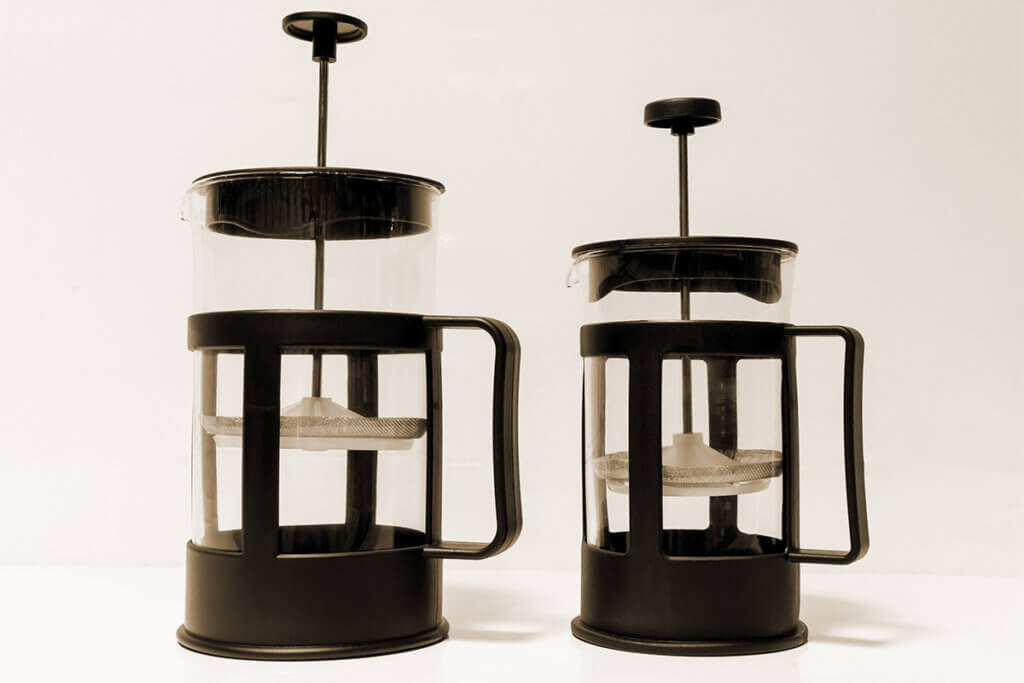
Each French press is designed for a specific capacity. If you only want to make two cups in a one-liter pot, use less coffee grounds than for a whole fill. When the plunger is pressed down, not only coffee grounds but also water is trapped under the sieve. This makes it easier for bitter substances to be released into the coffee. Although good coffee can also be made with half the filling quantity, it is advisable to always fill a French press completely. If you want to be flexible, you need different sizes in the kitchen.
Materials and quality
A French press must be sturdy. A poorly made coffee press poses a risk of injury. The different materials such as glass, stainless steel, and ceramic each have specific properties. One of the most important parts of a French press is the plunger. In terms of workmanship, it is important that it doesn’t wear out too quickly and is easy to clean. It is not advisable to use a plastic plunger, as the hot water will leave clear signs of wear after a while. Moreover, the plunger should not have too many individual parts, such as screws. These can fall off in the dishwasher. In the worst case, this will break the machine.
Use the right utensil for stirring
To protect the French press, stir with a wooden or plastic spoon if possible. A metal spoon scratches stainless steel and ceramics, and a glass jug can break in the worst case.
Design
The French press is a perfect example of the principle “form follows function”. According to this guiding principle from product design and architecture, the form of an object should be derived from its function. French presses embody this idea through the cylindrical beaker. Many models come across as deliberately simple and minimalist.
French presses are ideal for anyone who values stylish kitchen equipment. Especially the classic from Bodum, the Chambord beaker, is a true design icon. In addition to glass, stainless steel and ceramics offer exciting design options. Steel looks elegant and minimalist. Ceramics can be decorated with ornaments or finished with color. Designs made of ceramics and metal get by with few or no plastic elements at all.
Cleaning
Cleaning a French press is not difficult. You can rinse the beaker with water. The rest of the cleaning is done under running water. Afterwards, the French press is ready for use again. A basic cleaning should also be carried out regularly. To do this, the mesh must be easy to remove and the plunger disassembled into its individual parts. It is sufficient to wash the parts under hot running water. Many French presses are also dishwasher safe.
The sum of its individual parts
The mesh consists of three parts: a metal mesh with round holes on top, a fine-mesh strainer in the middle, and a spoke-shaped frame underneath.
Brands and models
Bodum dürfte der bekannteste Hersteller von Pressstempelkannen sein. Der Hersteller ist dafür bekannt, einfallsreiches Design zum kleinen Preis anzubieten. Bodum-Produkte gelten als langlebig und robust. Die Pressstempelkannen bestehen klassischerweise aus einer Kombination von Borosilikatglas und Edelstahl-Streben. Der Durchbruch gelang dem dänischen Unternehmen 1974 mit der French Press Bistro. Das Modell gewann nicht nur zahlreiche Designpreise, sondern wurde auch für seine Umweltfreundlichkeit ausgezeichnet. Mit der Zeit kamen zu der French Press aus der Produktreihe Bistro noch andere Modelle wie Chambord, Columbia und Brazil.
Bodum might be the most well-known manufacturer of French presses. The manufacturer is known for offering creative designs at a low price. Bodum products are considered durable and robust. They are typically made of a combination of borosilicate glass and stainless steel struts. The Danish company made its breakthrough in 1974 with the French press Bistro. The model not only won numerous design awards, but was also recognized for its environmental friendliness. Over time, the French presses from the Bistro range were joined by other models such as Chambord, Columbia, and Brazil.
The Italian cult brand Bialetti is not only popular in its home country. Internationally, the Italian coffee craft enjoys a very good reputation. The most famous product of this brand is the moka pot, which is placed on the stove. It is often simply called the “Bialetti pot”. Bialetti stands for high-quality workmanship and products that coffee lovers will enjoy for a long time. The Italian manufacturer’s French press is made of borosilicate glass and stainless steel. Bialetti has a smaller and less versatile range of French presses than Bodum. There are three models — Preziosa, Simplicity, and Trendy — in a variety of sizes. However, the functionality of the Bialetti and Bodum coffee makers is identical. The choice depends solely on personal taste and budget.
The ceramic models of the French brand Le Creuset are an exciting alternative to glass-plastic combinations and stainless steel pots. The manufacturer of kitchen utensils is known for its bright, friendly colors and handy shapes. On the breakfast table, such a French press is a visual highlight. The ceramic is also very robust and scratch-resistant. The models from Le Creuset also manage without plastic, only stoneware and stainless steel are used. The disadvantage of ceramic is that the French press is quite heavy at 2.8 pounds (1.3kg), which affects handling.
A cheap French press is already available from $10. Better and very durable models cost only a little more. Brand-name products are also affordable. In terms of functionality, they are all more or less the same. It is the material and workmanship and therefore the durability of the product that differ most from model to model. It is important that the beaker is stable and doesn’t get too hot, and that the mesh is of high quality and easy to disassemble. Taste depends on proper use of the pot and personal preferences. With expensive French presses from brand manufacturers, you mostly pay for the sophisticated design, quality materials, and workmanship.
Making coffee the right way
In order for the coffee to turn out well, a few steps must be followed. Even beginners can directly make a delicious coffee if they follow them:
1. Choose the right grinding degree
To ensure that no residues of the powder remain in the coffee, the right grind must be selected. The coffee powder must be coarser than the one used for paper filters. A medium grinding degree is recommended. You can get pre-ground powder in a coffee roastery or from online retailers. Otherwise, you can grind the coffee beans yourself using a coffee grinder. Approximately 2.1 ounces (60g) of coffee powder are required for one liter of water.
2. Boil water
After the water has boiled, let it cool for about 30 seconds so that it reaches the optimal temperature of about 203 °F (95 °C). Higher temperatures can release unwanted bitter compounds from the coffee powder.
3. Pour water and let the mixture steep
The water can be poured briskly over the powder in the beaker. Stir the coffee-water mixture with a – preferably wooden – spoon so that the powder is distributed, and the flavors are optimally released. After that, put the lid on and press the plunger down slightly so that no coffee powder floats on the surface of the water. The whole thing is now left to brew. Depending on preference, you can shorten or lengthen the infusion time.
4. Press down the plunger
The plunger is now pressed down slowly and steadily. A resistance should be noticeable. If the pressing is too light, the coffee powder is already at the bottom of the jug. In this case, you have waited too long. If it works only with difficulty, the grind was too fine and the many particles in the liquid offer resistance.
5. Pour the coffee and enjoy
Pour the coffee directly into a mug or transfer it to a pot. Otherwise, aroma continues to be released and quickly make the coffee bitter.
Image 1-2: © FinalCheck | Image 3: © v74 / stock.adobe.com

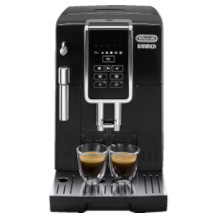
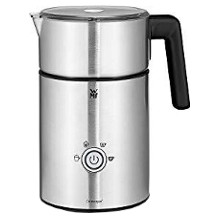
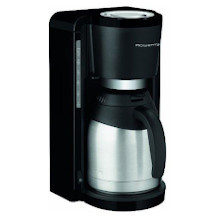
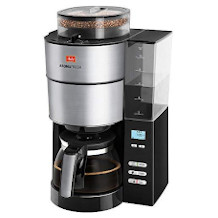

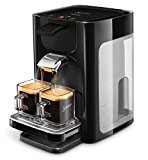
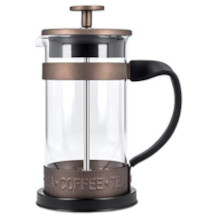
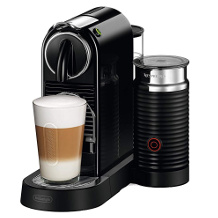
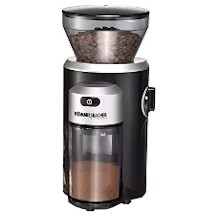
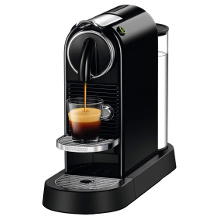



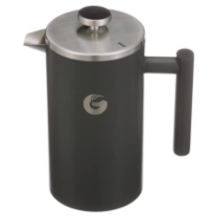
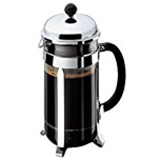
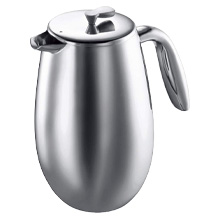
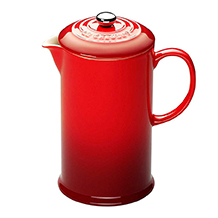
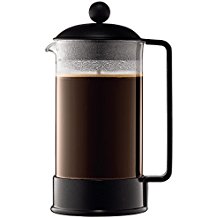
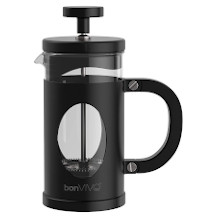

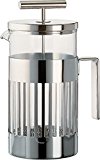

 1,473 reviews
1,473 reviews







